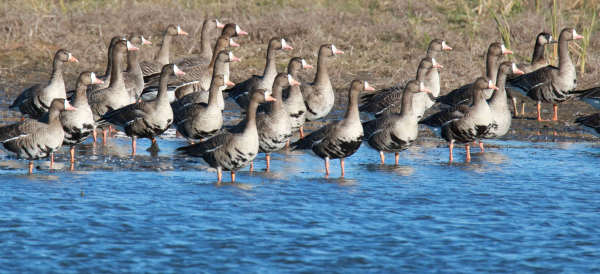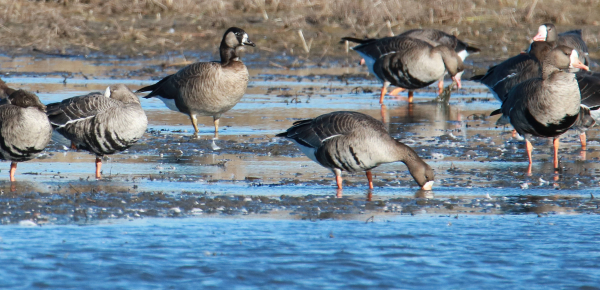Once again, when I least expected it, a bird came into view from behind a curtain of other birds. At first sight, it appeared to be a simple I.D. with a Cackling Goose walking into view from behind more than 100 White-fronted Geese. Interesting, but there was also a big Giant Canada Goose towering over the flock, so a Cacking Goose wasn’t the only outlier. But wait; this bird that appeared to be a “Cackling” goose had bright white plumage surrounding the base of its bill – that’s not quite right.
Certainly, the bird’s black neck and head and its size suggested a Cackler, but its cheeks were colored tan rather than bright white – that was worth a second look. But once again, the feathers between its bill and eyes were white – like the White-fronted Geese that surrounded it. Hmmm.
I was already photographing the goose in question, although it mostly stayed out of sight on the far side of the flock. Eventually, I realized this goose’s legs and feet were yellow (Cackling Geese have black legs and feet; White-fronts have orange legs and feet); and its bill was gray with a black outline (Cackling Geese have a black bill; adult White-fronts have an orange or pink bill). Were the unusual colors of the legs, feet, and bill the result of a mixing of unfamiliar genes? No doubt in my mind, this unique bird is a super-rare hybrid between 2 Arctic-nesting species – a Cackling Goose and a White-fronted Goose. I got photos – prove me wrong.

A broad curtain of White-fronted Geese almost conceals a unique hybrid goose; note the black-necked goose near the far right side of the photo.
But what happens when you are a birder without a camera?
You tell what sounds like a tall tale? You swear you saw what you saw? Not good enough! Where’s the proof? Where’s the photograph? You MUST document and prove your sighting when you find a rare bird, a rarer hybrid, or a uniquely colored bird – perhaps a leucistic or melanistic individual, or even an albino. Those scenarios are personally exciting, but we birders are prone to want to share our sightings with fellow birders, and maybe even brag a little. There are always disbelievers in the crowd, but when you have a photo, or better yet a series of photos to back up your super-rare sighting, then your word is golden.
This is a simple call to all birders: A camera is NOT an optional piece of birding equipment. It is the most important birding equipment for all birders. Binoculars? They are optional if you have a telephoto lens or a long-range zoom lens to look through on your camera. I often use my camera lens instead of binoculars, although it’s obviously best to use both. Spotting scope? Same story. But try and take a quick documentary photo with binoculars, or a spotting scope. Sure you can get an adaptor to fit onto your spotting scope to take documentary photos, but what percentage of birders actually do that? And is that option always at the ready when a rare bird appears? Or do you need to attach the adaptor and camera and set up the spotting scope on a tripod first? Cell phone photo? Forget about it!

The clearest documentary photograph of the apparent hybrid Cackling Goose x White-fronted Goose shows a number of tell-tale signs of this goose’s ancestry.
Now that’s not to say you don’t need a binocular or spotting scope; but realistically, every birder should have a camera with a telephoto lens in hand. And not just in case you see a rare or unusual bird. By using a camera as your primary element of birding equipment, it will open a whole dimension of birding for you to enjoy on another level of appreciation. Explaining that can sometimes be “like trying to explain rock and roll,” but you’ve gotta try it to begin to get an impression of what I’m trying to explain.
As I wrote last week: “Photographing birds often encourages us to spend more time with them, to study the birds closer, and appreciate the importance of watching and waiting to see what might happen next – or what different bird might slip into view. Photographing birds absolutely makes birding more enjoyable in the field – and as you review and edit photos after your close encounters of an avian kind.”
Photo Reviews
Even if you think you have all your bases covered related to your rare or unusual bird observation, consider this: When I was describing the hybrid goose, and making a case for its mixed ancestry, the color of the bird’s legs and feet came to mind. The color would add another element to emphasize the hybrid theory. By enlarging 2 photos I took, I could ascertain the yellow color of the gooses legs, and only 1 photo showed the like color of its feet. Photos allow you to magnify a bird’s image to almost ridiculous levels that can reveal things you never could have seen using binoculars, or even with your telephoto or super-zoom lens.
Then too, I referred to my photo library to double check on the attributes of normal Cackling and White-fronted Geese to double-check leg and foot colors, as well as the color of different individual’s beaks and their cheeks. Of course, anyone can refer to their favorite field guide to birds, or a couple of them, if you don’t have an expansive photo library.

This photo of a pair of White-fronts and a trio of Cacklers provides a look at what pure-blooded individuals of these species look like, and how the hybrid goose has some traits of both, and lacks traits of each species.
Keep in mind that hybrids between different species of birds are usually very rare, and they are extremely rare between birds from different genus, which is the case between the 2 species of geese in question. There are many behavioral cues that usually keep different species apart during the pairing and breeding periods. There are also genetic differences between different species that usually prevent viable gametes or embroyos of cross-species and cross-genus copulations. Even if a hybrid survives to hatch, they probably tend to be less likely to survive thereafter than pure-blood individuals. Realistically, there aren’t many hybrids out there for a number of reasons – making this find an exceptional one for this alert birder.
During this exciting period of fall migration, you never know what bird or birds might suddenly appear before you, might stop over at your favorite birding location, or even in your own yard. By all means, take advantage of the photo surprises that unfold, and be prepared for the next rare, unusual, or profound bird you get to see – and document it with photographs.
Article and photographs by Paul Konrad
Share your bird photos and birding experiences at editorstbw2@gmail.com